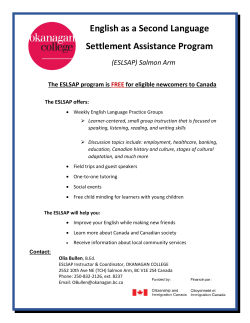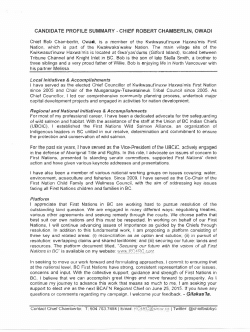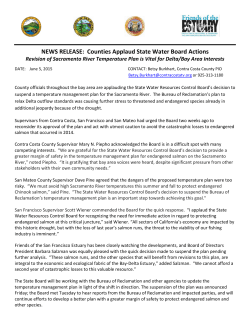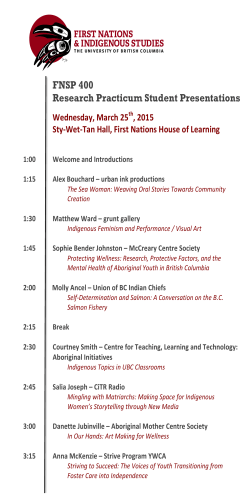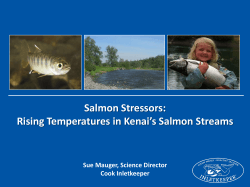
Response to consultation on proposals to introduce a kill licence for
Protecting Scotland’s wildlife for the future Jackie McDonald Area 1-B North, Victoria Quay, Edinburgh, EH6 6QQ. 30-04-2015 Dear Jackie, Consultation on proposed conservation measures to introduce a licensing system for killing wild salmon in Scotland Please find below the Scottish Wildlife Trust’s responses to the questions posed in the above consultation document. In summary, we warmly welcome the principles of a licencing system for the killing of wild salmon supported by a carcass tagging scheme. We considered it entirely reasonable and long overdue to bring in measures across Scotland to ensure that only those salmon stocks that can be shown to exceed conservation limits are open to exploitation. Yours sincerely, Alex Kinninmonth Living Seas Manager 0131 312 4749 [email protected] Patron HRH The Prince Charles, Duke of Rothesay Chairman Robin Harper Chief Executive Jonny Hughes Scottish Wildlife Trust Harbourside House 110 Commercial St Edinburgh EH6 6NF T 0131 312 7765 F 0131 312 8705 E [email protected] W scottishwildlifetrust.org.uk The Scottish Wildlife Trust is a company limited by guarantee and registered in Scotland (registered no. SC040247). It is also a Scottish registered charity (charity no. SC005792) Scottish Wildlife Trust response to proposed conservation measures to introduce a licensing system for killing wild salmon in Scotland Q1. Do you agree with the proposal that Scottish Ministers introduce, for conservation reasons, a ban on killing wild salmon by all methods except under licence? If you disagree, please provide suggestions for alternative measures which, within the context set out in the consultation paper, would deliver the objective of a more robust regulatory framework to control killing of salmon to enable conservation objectives to be met. A: Yes. The status quo is unacceptable. The introduction of a ban on the killing of Atlantic salmon except under licence was a key recommendation of the Wild Fisheries Review and the conservation case is made clear in the consultation documentation. We therefore warmly welcome the Scottish Government’s stated intention to make fundamental changes to ensure that the exploitation of salmon by any means is sustainable, does not present a threat to vulnerable stocks, and is compatible with international obligations such as those under NASCO and the Habitats Directive. The proposed measures should not however be seen as a ‘silver bullet’ as there are multiple pressures that remain to be addressed both in home waters (e.g. water quality, physical barriers, impacts of coastal fish farming) and with regard to marine survival. We have some concern that it is not the intention of the proposals to introduce a ban on the killing of sea trout, which remain under significant pressure in parts. The Wild Fisheries Review Panel recommended that the sustainability of sea trout harvesting should be kept under close review and we seek assurances that the Scottish Government are committed to this, and that the introduction of a ban on killing salmon does not unintentionally result in additional exploitation of sea trout. Q2. Do you agree with the basic outline of how the licensing system would operate? Please provide suggestions, and rationale, if you consider it should operate in a fundamentally different way. A: Yes, in as much as it is described at this point. As is required by the primary legislation, the principle driver of decision-making under such a system must be the conservation of the species, which in turn supports compliance with the agreements made under NASCO and the legal requirements of the Habitats Directive. We firmly support these commitments, and in our view the licencing scheme must work together with the establishment of conservation limits and management targets (as defined by NASCO) such that the killing of salmon should only be permitted where there is sound evidence of an exploitable surplus. The success or otherwise of the licencing system will rely heavily on the development of a sound scientific basis for setting management targets. The introduction of a licencing system must therefore also come with a strong commitment from the Scottish Government to provide sufficient resources to realise the recommendations of the Wild Fisheries Review in relation to sound science, including the research and data gathering that will provide the necessary foundation for evidence-based licensing decisions that all sectors can have confidence in. Furthermore, a key principle of the licencing system must be proper application of the precautionary approach as agreed to by the Contracting Parties of NASCO. This is particularly appropriate with regard to coastal Mixed Stock Fisheries, which present particular difficulties for management. ICES advice for 2013-2016 states that on the basis of the MSY approach, “fishing should only take place on salmon from rivers where stocks have been shown to be at full reproductive capacity. Furthermore, because of the different status of individual stocks within stock complexes, mixed-stock fisheries present particular threats. The management of a fishery should ideally be based upon the individual status of all stocks exploited in the fishery.” In line with this advice, NASCO guidelines for the management of salmon fisheries stipulate that management measures should be aimed at maintaining all stocks above their conservation limits (the spawning stock level that produces maximum sustainable yield) by the use of management targets. Therefore, if following these guidelines, where it is not possible to determine the status of the individual stocks being exploited it would not be appropriate to issue licences allowing salmon to be killed. 2 Q3. Do you agree that the ban on killing and associated licensing system for Atlantic Salmon should be accompanied by regulations prohibiting use of certain fishing equipment which is liable to cause greater harm to the fish? What other equipment, other than that set out at paragraph 24, do you consider should be included and for what reason (please provide evidence for your suggestions if possible)? A: Yes. This measure is necessary to improve the likelihood of survival in catch and release. We offer no further suggestions. Q4. Do you agree that a carcass tagging scheme be made as an integral part of the licensing system to aid compliance? A: Yes. The introduction of a carcass tagging scheme in Scotland should be seen as an essential component of the new licencing regime, aiding compliance with legislation and offering a means of collecting reliable catch data. This was the basis under which the amendments to the Salmon and Freshwater Fisheries (Consolidation) (Scotland) Act 2003 concerning carcass tagging were agreed by the Scottish Parliament in 2013. The detail of the proposed regulation is not included in the consultation document however we would expect any such scheme to include as a minimum the requirement for fish to be individually tagged and for the details to be recorded, along with the unique tag number, in a logbook. A system of carcass tagging, working in combination with the existing ban on sale of rod caught salmon would ensure that only legitimately captured fish, easily identifiable by tags that are only issued to licensed netting operators, are offered for sale and any untagged fish would therefore be deemed to have been caught illegally. The proposed scheme would not only help tackle poaching in adherence with international obligations to reduce the levels of illegal and unreported catch, but would improve the reliability of catch data (as each caught fish must be tagged and each tag accounted for), in turn aiding stock assessment and the conservation of salmon. The introduction of a statutory system of carcass tagging is a long overdue measure. The need for UK wide coverage of statutory carcass tagging was identified in the 2000 Review of Salmon and Freshwater Fisheries in England and Wales. Ten years later the Scottish Mixed Stock Salmon Fisheries Working Group noted in its 2010 report that the situation under the 2009 England & Wales byelaw requiring carcass tagging of net caught salmon and migratory trout in conjunction with the ban on sale of fish caught by rod and line it was “less likely to be effective as long as it applies only to salmon caught south of the border, given that untagged salmon and sea trout from Scotland will also be present in fish markets.” The report further remarked “the value of tagging within the UK as a whole would be much strengthened if this measure were adopted in Scotland in respect of all wild salmon placed on the market.” We understand that as the proposed licencing scheme will not extend to sea trout, they will not be included in the carcass tagging requirement. It is our view that carcass tagging should also be extended to sea trout. With no statutory carcass tagging scheme for sea trout in Scotland, enforcement of the ban on sale of rod caught sea trout is potentially compromised. Furthermore it fails to close the loophole whereby illegally captured sea trout from England or Wales could potentially be marketed as “Scottish sea trout” in an explanation for it having no Environment Agency tag. Useful lessons for Scotland should be learned from the experience of the Environment Agency administered scheme. Although there are key differences between the proposals being consulted on here and the system operating in England & Wales (e.g. the number of tags issued is not currently limited in E&W), compliance with the carcass tagging system is considered to be good. An Environment Agency assessment conducted after the first year of operation identified some teething problems but found overall support for the measures from the net fishing industry. In 2013 all logbooks were accounted for and only 10 out of 304 netsmen required a first reminder.1 1 https://www.gov.uk/government/uploads/system/uploads/attachment_data/file/383598/Report2013.v2.pdf 3 An effective means of differentiating between fish killed in a rod and line fishery (for which it is not legally permissible to offer for sale) and those that originate in a net fishery (that can legally go to market) should be implemented. Different coloured tags for each method would appear to be the simplest way of achieving this. Q5. What do you consider the main impacts of the package of measures to be? A: The package of measures will benefit the conservation of Atlantic salmon in line with international obligations and will in turn ensure the long term viability of salmon fisheries by obligating them to be carried out within environmental limits. Beyond the pure economic value associated with salmon fisheries, salmon is one of a special group of native species with widespread recognition and cultural significance. Salmon consistently scores highly as a species associated with Scotland in surveys of the Scottish public. A survey conducted in 2011 found that 91% of the Scottish public are glad that wild salmon are in Scotland’s rivers, and when asked to rank the importance of different aspects of the natural environment and its management, wild salmon comes behind only clean and litter free coastal waters and beaches and well-maintained urban parks.2 In addition to the conservation of salmon, the closure of any possible route for selling fish from illegal netting would have wider conservation benefits, as there is considerable risk for marine mammals and birds to become trapped in active, or abandoned, coastal nets. Monofilament nylon nets are for example very difficult for marine mammals, sharks and birds to detect and they can, and have, become entangled and drowned (see for example Police Scotland News “Poacher's Illegal Net Kills Porpoise”). Potentially impacted species include bottlenose dolphin, harbour porpoise, common seal, basking shark and otter that all have protected status in their own right and are equally iconic components of Scotland’s wildlife. Overall improvements in Atlantic salmon stocks could also contribute to the conservation of the critically endangered freshwater pearl mussel as its reproduction and distribution is critically linked to the freshwater phase of the salmon life cycle. The proposed measures will introduce a quota for all salmon fisheries, by way of the number of tags issued under the terms of any licence issued. This represents a significant change to current practice where there is currently no overall control of the number of salmon that can be taken in a fishery. We understand that depending on the licence decision this could result in a restriction on the potential catch, and therefore potential loss of earnings, in the netting sector. However, recreational fisheries could continue on a catch and release basis even where there is no kill licence. While we agree that there should be no automatic right to compensation for impacts incurred by necessary conservation measures, we understand that there could be a case for fair compensation to be negotiated between those parties that will benefit from the introduction of greater control of the number of salmon killed and those that stand to potentially lose out. Q6. Do you have any other observations about the proposals as conservation measures to help regulate exploitation of Atlantic salmon? In the context of the legal framework in Scotland, do you have any suggestions or options for how they might operate in practice? A: No. 2 http://www.snh.gov.uk/docs/B941737.pdf 4 Consultation on proposed conservation measures to introduce a licensing system for killing wild salmon in Scotland RESPONDENT INFORMATION FORM Please complete the form below to ensure that we handle your response appropriately SECTION 2: Complete this section if you are responding on behalf of a group or organisation Group/Organisation details Name: Scottish Wildlife Trust Postal address (including post code): Harbourside House, 110 Commercial St., Leith, EH6 6NF Contact details (telephone number/email address): 0131 312 4749 [email protected] Handling your response N.B. the name and address of your group/organisation will be published Q: Are you also content for your response to be published? A: Yes 5
© Copyright 2026
